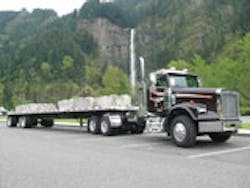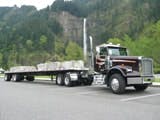Freightliner FLD-SD Has Old-School Style, Modern Mechanicals
You like to drive? This is a truck for you, especially if you've got some years and miles behind you, because Freightliner's FLD-SD daycab tractor is "old school." It's the last FLD the builder makes, and aside from its some traditional but still highly serviceable components, it was a pleasure to operate, with a powerful and strong-sounding Detroit engine and a smooth shifting Eaton Fuller 13-speed transmission. It was adorned with lots of chrome and polished metal, and it had a fancy interior. It turned out to be one of those trucks that I didn't want to return.
The FLD-SD (for FreightLiner, D-series chassis, severe duty) uses an aluminum cab that dates to the 1980s, with squarish lines and an upright V-shaped windshield with two pieces of flat glass, the kind fleet managers used to favor because they were cheap to replace after being dinged and cracked. The high cost of fuel has caused builders to go to curved aerodynamic surfaces, including windshield glass, but fuel economy is less important in many construction-oriented applications, so the old design can still make sense.
So does the forward-thrusting nose, which is emphasized by this tractor's setback front axle. There's plenty of room under there for the engine — a Detroit Diesel Series 60 — the radiator, and all other accessories needed to keep it and the truck working. The tens of thousands of FLD road tractors that once roamed North American highways (many still do) have flat grilles but sloped and rounded hoods, while the hood on the SD is higher and more squared in front, suggesting the tougher frame and other components that qualify it for rough service.
The interior is straight out of the highway-type FLD, with a high two-piece instrument panel whose right wing cants toward the driver. It has an array of switches and gauges that complement the speedometer, tachometer, and engine-condition and air-pressure gauges directly ahead on the main panel. Yeah, the headlight switches are at the base of the wing panel, almost hidden behind the steering wheel, but they didn't bother me as they have in the past because it was a sunny day and I seldom needed to use them.
And the panels were laid over with a handsome faux-wood facing that contrasted nicely with the chrome bezels circling the gauges. I don't recall ever thinking of an FLD's instrument panel as attractive, but I immediately became fond of this one. Freightliner has long since built the more modern Century and Columbia, and even they have a replacement in the new Cascadia. All have wider, smoothly sculpted cabs and all come in non-sleeper daycab versions. But for construction and other heavy vocational duties, the FLD-SD is still the main one Freightliner offers.
One reason it's still in production is that Freightliner builds them for the U.S. Army, which since 1989 has bought thousands of olive-drab and dessert-camo-colored tractors and dump trucks, and I wrote about them several years ago. All of those are powered by Detroit Series 60s, but with pre-'07 specs. Overseas, including war zones, the military feeds most trucks and aircraft with JP8 fuel, which is closer to kerosene and has too much sulfur for civilian trucks' diesel particulate filters. So military versions don't meet current emissions limits, but that becomes less important when bullets are flying and bombs are exploding.
The Series 60 in this black tractor was '07-legal, so its fuel and combustion systems were high-tech and its stack was dominated by the burly DPF. But meeting still tougher exhaust emissions limits in 2010 will require new approaches. So the Series 60 will be phased out by the end of '09 while the new "DD" series, starting with a DD15 that's now available, is phased in. But you won't see the DD in the FLD-SD, as its days are numbered, too (more on that later).
The Series 60 remains a capable engine, and in '07 form has a muted snarl that's pleasing to the ear. It's standard in this chassis, while the lighter Mercedes MBE 4000 and the heavier Caterpillar C15 are optional. This Detroit had 450 horsepower and 1,650 pounds-feet of torque seemingly eager to get to work.
In the back lot of Freightliner's test center in Portland, Ore., I fired it up and backed the tractor under the nose of a 48-foot Transcraft Eagle aluminum-and-steel flatbed trailer. A crew had loaded it with big-old concrete blocks that weighed it down and gave us a gross combination weight of about 78,000 pounds.
I gave the rig a visual once-over and got on the road, or streets, as is the case in Portland's Swan Island industrial section, where Freightliner is headquartered. Leaving there involves a short but steep upgrade on Channel Avenue until the exit onto International Drive; the big Detroit pulled strongly in 6th and 7th gears, which I split to keep revs below 1,600 to 1,700. I watched the right-hand mirror while on the ramp to be sure I was keeping the trailer's tires away from the curb as I downshifted to 5th and again played with the splitter (what fun!). Then it was downhill on the four-lane street until the on-ramp to I-405, and within a mile or so I swung eastward on I-84.
While making any appreciable amount of power, the Detroit emitted a mellow bellow that was reminiscent of the old, less muffled days. Its low-frequency growling makes it the nicest sounding engine you can buy right now; it's the next best thing to a 4- or 5-inch-diameter straight pipe, if you could have one, which you legally cannot because that would require removing the particulate filter.
But most diesels built since October '02, when really tough EPA rules went into effect, have had more than their share of problems, according to fleet reports at industry maintenance meetings.
While many '07 models deliver better fuel economy than before, Detroits use somewhat more. This is due to frequent active regenerations to clean out the DPFs, during which fuel is squirted into the exhaust stream to create needed heat. Testing has shown that fewer regens are needed, and Detroit says it has cut back on the "aggressive" programming of electronic controls that made them happen. This should improve economy by 2 percent or more.
An average driver might not be aware of such details unless he or she owns a truck, and ponders them while going down the road. By now I was eastbound on I-84, which follows some sweeping curves whose radii soon grow greater. As traffic thinned I went from 7th to 8th, the splitter box first in Direct and then in Overdrive as the Detroit willingly picked up the pace. I had noticed the speedometer needle seemed to be stuck down at 35 and 40 mph, but at an indicated 60 mph I was passing everything and it occurred to me that I was moving a lot faster than 60. Slow 'er down, boy, I told myself, and eased up on the accelerator to go with the traffic flow. Obviously the speedo was miscalibrated, and I wrote it up later.
On 84 I proceeded up the wide Columbia River Gorge — a masterpiece of scenery that everyone should see at least once — and after an enjoyable 40 miles I pulled into the Multnomah Falls rest area, which sits between the east- and westbound lanes. Here I have a routine: I proceed to a turn-around at the area's east end and put the tractor through a brief maneuvering test. If I can make the sharp left-hand turn without dragging the trailer's tires over the curb, the tractor "passes."
This time the tire sidewalls didn't even kiss the curb — pretty good, as the trailer had a wide-spread tandem whose second axle was at the vehicle's very rear. The tractor's setback steer axle allows room for the wheels to cut tightly toward the frame, making for a sharp cut leftward at the end of the maneuver. Weight laws in some states might require a forward-set steer axle, especially for straight trucks, but this tractor's long (for a daycab), 221-inch wheelbase makes this one usable even in bridge-formula states.
On the way back to Portland, I considered that although it's a "work truck," this FLD-SD was comfortable and smooth riding. And, not withstanding the engine's gutteral utterances and wind noise caused by old-style mirror brackets and flat sheet-metal surfaces, it was rather quiet. If pulling a lowboy or equipment trailer — a likely job for this tractor — such considerations are less important because much time would be spent at jobsites, loading or unloading machinery. There a driver might pause to admire this dated but still graceful conveyance.
If he or his boss wants to buy another, he'd better act within the next year and a half. Freightliner won't engineer any of the 2010-legal diesels into this model, so the FLD-SD will go out of production by the end of '09. It will be replaced by a new vocational model; Freightliner isn't saying what parts it will use, what it will look like or what it will be named. But it won't be based on the M2 series, because although that has heavy, V-for-vocational versions, some buyers perceive M2s as medium-duty trucks. The new model will be strictly Class 8, and here's hoping it'll drive as nicely as this one.





